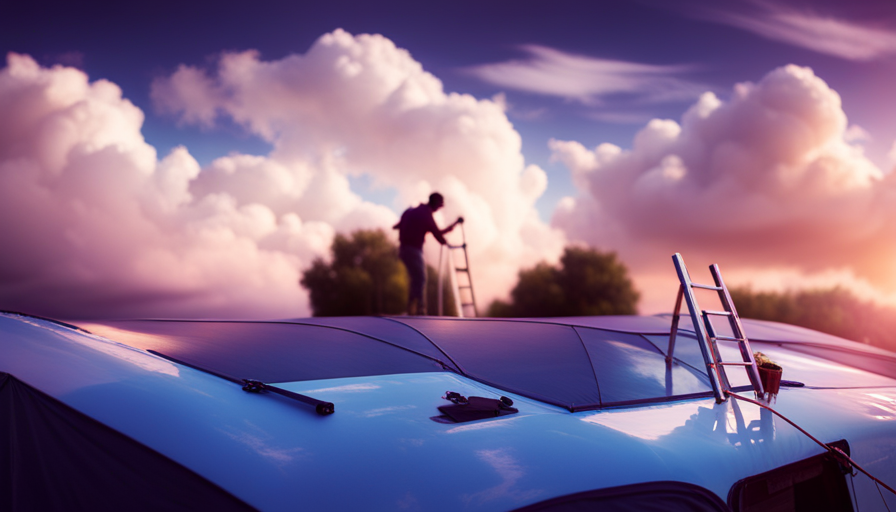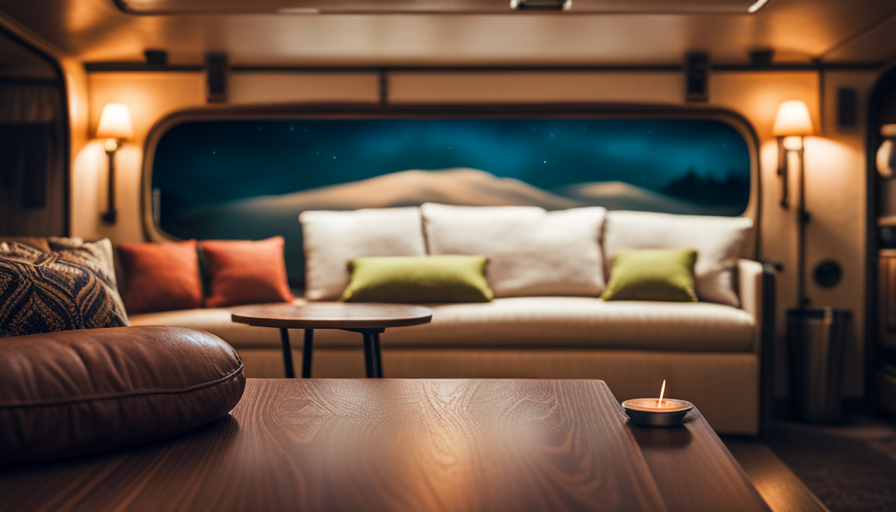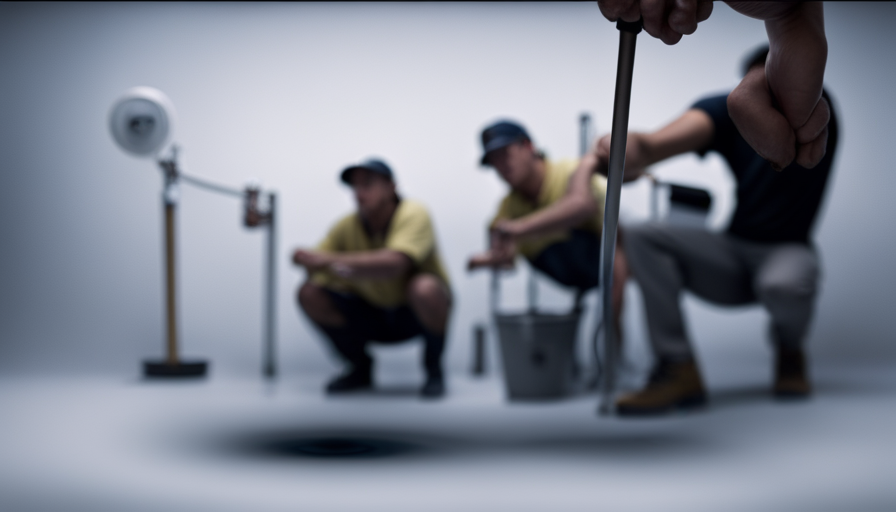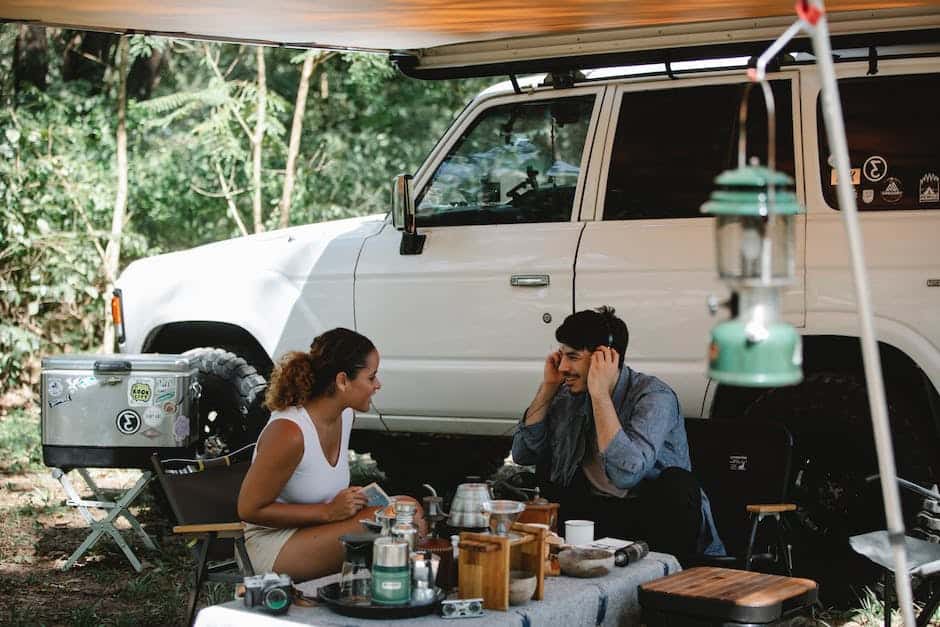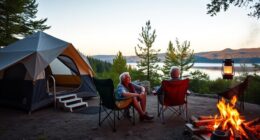I understand your concerns – the idea of painting a pop-up camper roof may seem intimidating. However, I assure you that with the proper materials and some basic knowledge, it can be a manageable project.
In this article, I’ll walk you through the step-by-step process of how to paint your pop-up camper roof, so you can give it a fresh new look and protect it from the elements.
Before we dive in, let’s gather all the necessary supplies, such as primer, paint, brushes, and tape. Once you have everything ready, it’s time to clean the roof thoroughly and remove any accessories or obstacles that might get in the way. Don’t forget to tape off and protect the surrounding areas to avoid any unwanted paint splatters.
Next, apply a primer to ensure proper adhesion and longevity of the paint. Once you’re done painting, it’s important to clean up and dispose of any waste properly, as we care about our environment.
After completing the job, take a moment to inspect your newly painted roof for any touch-ups. Finally, allow sufficient drying and curing time before you can enjoy your beautifully painted pop-up camper roof.
So, let’s get started and transform your camper into a stylish and protected haven!
Key Takeaways
- Gathering the necessary supplies and properly cleaning the roof are essential for a successful paint job.
- Taking precautions and wearing protective gear ensure safety during the painting process.
- Using the right primer and paint for outdoor use helps to achieve durability and longevity.
- Regular maintenance, such as cleaning, touch-ups, and applying a protective sealant, is important to preserve the painted roof’s appearance and functionality.
Gather the Necessary Supplies
Now, it’s time to gather all the supplies you’ll need to paint your pop up camper roof. Before you begin, it’s important to ensure you have the right protective gear to keep yourself safe throughout the process.
You’ll need a pair of goggles to protect your eyes from any paint splatters or debris. Additionally, a respirator mask will help filter out any harmful fumes from the paint.
Next, you’ll need to choose the right type of paint for your pop up camper roof. It’s crucial to select a paint that is specifically designed for outdoor use and can withstand the elements. Look for a high-quality acrylic or enamel paint that is resistant to fading, cracking, and peeling. Consider the color you want as well, as a lighter shade can help reflect sunlight and keep the interior of your camper cooler.
With your protective gear and paint ready, it’s time to move on to cleaning the roof. But before we do that, make sure you have a sturdy ladder and a power washer or a hose with a high-pressure nozzle.
Clean the Roof
First, make sure you’ve cleared away any debris or dirt from the top of your camper. This is an important step in preparing the roof for painting. Start by using a broom or a brush to sweep away any loose dirt or leaves.
Next, you’ll want to use a cleaning solution specifically designed for camper roofs. These solutions are usually available at your local hardware store or RV dealership. Mix the solution according to the instructions and apply it to the roof using a soft brush or sponge. Scrub gently to remove any dirt or stains.
Rinse the roof thoroughly with clean water to ensure that all the cleaning solution is removed. This step is crucial for proper roof maintenance and will help ensure that the paint adheres properly.
Once the roof is clean, you can move on to the next step, which is removing any accessories or obstacles that may be in the way of painting the roof.
Remove any Accessories or Obstacles
Before I start cleaning the roof of my pop-up camper, I need to take off any roof racks or luggage racks that may be attached. This will ensure that I have a clear and unobstructed surface to work with.
Next, I will remove any antennas or satellite dishes that may be mounted on the roof. This will prevent them from getting damaged during the cleaning process.
Lastly, I will clear the roof of any debris, such as leaves or branches, to ensure that I have a clean surface to work on.
By removing these accessories and obstacles, I can ensure that my cleaning process will be smooth and effective.
Take off Roof Racks or Luggage Racks
To start prepping your pop-up camper roof for painting, you gotta remove them roof racks or luggage racks. These accessories can get in the way and make it difficult to paint the roof evenly. Plus, they can also get damaged during the painting process. So, it’s important to remove them and store them in a safe place before you begin.
Start by unscrewing any bolts or screws that are holding the racks in place. Be sure to keep track of all the hardware so you don’t lose anything.
Once the racks are off, you can protect the camper surfaces by covering them with plastic or drop cloths. This will prevent any paint or debris from getting on the camper itself.
Now, let’s move on to removing antennas or satellite dishes without causing any damage.
Remove Antennas or Satellite Dishes
Now, let’s tackle the antennas or satellite dishes on your camper – you’ll want to remove them carefully to avoid any damage.
Start by locating the TV antennas and radio antennas on the roof of your camper. Use a screwdriver or wrench to loosen and remove any screws or bolts holding them in place. Gently disconnect any cables or wires attached to the antennas. Be sure to keep track of the screws and bolts, as you’ll need them for reinstallation.
Once the antennas are removed, set them aside in a safe place. Now that the antennas are out of the way, we can move on to the next step: clearing the roof of any debris.
Clear the Roof of any Debris
Once the antennas are safely removed, it’s time to clear the roof of any debris, like leaves scattered like confetti after a celebration.
Before beginning, it’s important to take some safety precautions. Make sure to wear gloves and protective eyewear to avoid any injuries.
Start by using a broom or a leaf blower to remove any loose debris, such as leaves, twigs, and dirt. Pay special attention to the corners and edges of the roof where debris tends to accumulate.
Next, grab a bucket of soapy water and a soft brush. Gently scrub the roof surface to remove any stubborn dirt or stains. Rinse thoroughly with clean water and allow the roof to dry completely. This will ensure that the paint adheres properly.
With the roof clear of debris, it’s time to move on to the next step – tape off and protect the surrounding areas.
Tape off and Protect the Surrounding Areas
When preparing to paint the roof of a pop-up camper, it’s important to tape off and protect the surrounding areas. To ensure clean lines and prevent paint from getting on areas that should remain untouched, I recommend using painter’s tape to protect edges.
Additionally, it’s crucial to cover windows and vents with plastic or drop cloths to prevent any accidental overspray. Finally, it’s important to protect the rest of the camper from overspray by using additional drop cloths or plastic sheets.
Taking these precautions will help ensure a professional-looking paint job while keeping the rest of the camper clean and free from any potential damage.
Use Painter’s Tape to Protect Edges
To ensure clean and precise edges, you’ll want to grab some painter’s tape and carefully apply it along the edges of your pop-up camper roof before diving into the exciting world of painting. Painter’s tape is essential for protecting the surrounding areas from accidental paint drips or smudges. Here’s how to use it effectively:
-
Prepare surfaces: Before applying the painter’s tape, make sure the roof is clean and free from any dirt or debris. This will ensure that the tape adheres properly and creates a tight seal.
-
Choose the right paint: Select a paint that’s specifically designed for outdoor use and is compatible with the material of your camper roof. This will ensure durability and longevity.
-
Apply painter’s tape: Carefully place the tape along the edges of the roof, ensuring it’s securely attached. This will create defined lines and prevent paint from bleeding onto unwanted areas.
Now that the edges are protected, it’s time to move on to the next step: covering windows and vents with plastic or drop cloths.
Cover Windows and Vents with Plastic or Drop Cloths
As you embark on the journey of transforming your pop-up camper, take a moment to shield the windows and vents with the protective embrace of plastic or drop cloths. Choosing between plastic and drop cloths depends on personal preference, but both options serve the same purpose of safeguarding these vulnerable areas.
Plastic sheets provide a clear view, allowing you to monitor the progress of your project while keeping the windows and vents completely covered. On the other hand, drop cloths offer a sturdy barrier that can be easily draped over the windows and vents, ensuring maximum protection against overspray. By taking this extra precaution, you prevent any accidental paint damage to these delicate components of your camper.
Now, let’s move on to how we can protect the rest of the camper from overspray.
Protect the Rest of the Camper from Overspray
Make sure you cover every inch of your beloved mobile sanctuary to shield it from the overspray, as if it were a delicate flower in a storm.
Preventing overspray accidents is crucial when painting a pop-up camper roof.
To protect the rest of the camper, there are various paint protection methods you can choose from.
One option is to use plastic or drop cloths to cover any exposed surfaces, such as the sides, front, and back of the camper. This will ensure that the overspray does not reach these areas and cause unwanted paint damage.
Additionally, you can use masking tape to further secure the protection materials in place.
By taking these precautions, you can confidently proceed to the next step of applying a primer.
Apply a Primer
First, make sure you thoroughly clean the pop-up camper roof before applying the primer to create a smooth and even surface for painting. This is an essential step in the process because any dirt, debris, or previous coatings can affect the adhesion and durability of the primer. Start by washing the roof with a mild detergent and water, scrubbing gently with a soft brush or sponge. Rinse thoroughly and let it dry completely before moving on to the next step.
When choosing the right primer, there are a few key factors to consider. Look for a primer specifically designed for outdoor surfaces, as it’ll provide the best protection against weathering and UV damage. Also, choose a primer that’s compatible with the type of paint you plan to use.
Apply the primer using a roller or brush, starting at the highest point and working your way down. Be sure to follow the manufacturer’s instructions for application and drying times. Once the primer is dry, you can proceed with applying the paint, which I’ll discuss in the next section.
Apply the Paint
When applying paint to a pop-up camper roof, it’s important to use even strokes and apply multiple thin coats. This ensures a smooth and even finish. Additionally, it’s crucial to allow each coat to dry completely before applying the next one. This helps to prevent any smudging or unevenness in the paint job.
Lastly, pay close attention to the drying and curing time recommended by the paint manufacturer. This will ensure that the paint fully adheres to the surface and provides long-lasting protection.
Use Even Strokes and Apply Multiple Thin Coats
To achieve a smooth and professional finish, it’s important to paint the pop-up camper roof using even strokes and applying multiple thin coats. Here are some tips for achieving a smooth finish using the multiple coat technique:
- Start by using a high-quality paintbrush or roller to ensure even coverage.nn2. Apply the paint in one direction, using long and even strokes. This will help to prevent streaks and unevenness.nn3. Avoid applying too much pressure on the brush or roller, as this can create thick and uneven layers of paint.nn4. Allow each coat to dry before applying the next, following the manufacturer’s instructions.
By using even strokes and applying multiple thin coats, you can create a professional-looking finish on your pop-up camper roof. This technique allows the paint to adhere properly and ensures a long-lasting and attractive result.
Allow Each Coat to Dry Before Applying the Next
After using even strokes and applying multiple thin coats of paint to the pop-up camper roof, it’s crucial to allow each coat to dry before applying the next. This step is essential to ensure a smooth and professional-looking finish.
By allowing the paint to dry completely between coats, you prevent any streaks or smudges from forming. To facilitate drying, it’s recommended to leave the camper roof in a well-ventilated area with good airflow. Additionally, you can use drying techniques such as using a fan or a heat gun on a low setting to speed up the process.
When applying subsequent coats, make sure the previous coat is completely dry to avoid any issues with adhesion or color consistency. By following these paint application tips and drying techniques, you can achieve a flawless and long-lasting paint job on your pop-up camper roof.
Moving forward, it’s important to pay attention to drying and curing time to ensure a durable and beautiful finish.
Pay Attention to Drying and Curing Time
Make sure you carefully monitor the drying and curing time to achieve a durable and beautiful finish on your pop-up camper roof.
When it comes to drying techniques, it’s important to be patient and allow each coat to fully dry before applying the next one. Rushing the process can lead to a subpar result, with the paint not adhering properly or becoming easily damaged.
It’s recommended to follow the instructions on the paint can regarding drying times, as different types of paint may have varying requirements. Additionally, factors such as temperature and humidity can affect drying times, so it’s important to consider these factors as well.
By taking the time to properly dry and cure each coat of paint, you’ll ensure a long-lasting and professional-looking finish.
Now, let’s move on to the next section about how to clean up and dispose of waste properly.
Clean up and Dispose of Waste Properly
Before you start painting, it’s important to know how to properly clean up and dispose of waste when working on your pop-up camper roof. Proper waste disposal is not only important for the cleanliness and organization of your workspace, but also for the environment.
When painting your pop-up camper roof, you are likely to generate waste materials such as paint cans, brushes, and paint thinner. It is crucial to handle and dispose of these materials correctly to minimize their environmental impact.
Firstly, it is essential to clean your brushes and paint cans thoroughly after use. Use a solvent such as paint thinner to remove any excess paint, and then rinse them with water. Make sure to dispose of the rinse water properly, either by pouring it into a designated paint waste container or by allowing it to evaporate in a well-ventilated area.
When it comes to disposing of paint cans, check with your local waste management facility for specific guidelines. Some areas require you to dry out the cans before disposal, while others may have designated drop-off points for hazardous waste. It is crucial to follow these instructions to ensure that the paint cans are disposed of safely and responsibly.
Proper waste disposal not only keeps your workspace clean and organized but also minimizes the environmental impact of your painting project. After cleaning up, you can move on to the next step of inspecting the finished job.
Inspect the Finished Job
When inspecting the finished job of painting a pop-up camper roof, it’s important to carefully look for any signs of uneven coverage or drips. This can be done by examining the surface from different angles and checking for any areas that appear lighter or darker than the rest.
Additionally, it’s crucial to check for any damage or imperfections such as chips, cracks, or bubbles in the paint. If any issues are detected, I’ll make touch-ups as necessary to ensure a flawless and professional finish.
Look for any Uneven Coverage or Drips
Check out the awesome job you did painting the pop-up camper roof by looking for any uneven coverage or drips! When inspecting the finished job, it’s important to check for proper coverage and make sure that the paint has been applied evenly across the entire surface of the roof.
Look closely at the corners and edges to ensure that no areas have been missed. Additionally, pay attention to any paint drips or runs that may have occurred during the painting process. These can be easily fixed by lightly sanding them down and applying touch-up paint as needed.
Once you’ve checked for any uneven coverage or drips, you can transition into checking for any damage or imperfections that may need to be addressed.
Check for any Damage or Imperfections
Once you’ve finished admiring your masterpiece, be on the lookout for any sneaky imperfections or hidden damage that might need your attention.
Inspect the entire surface of your camper roof carefully, paying close attention to any signs of damage or wear. Look for cracks, tears, or holes that may have developed over time.
If you notice any damaged areas, it’s important to repair them before applying a protective sealant. Use a suitable patching material and follow the manufacturer’s instructions for proper application.
After the repairs are complete, give the patched areas enough time to dry and cure before proceeding. Once everything is dry, you can move on to applying a protective sealant to ensure the longevity of your newly painted roof.
Make touch-ups if necessary to achieve a flawless finish before moving on to the next step.
Make Touch-Ups if Necessary
After checking for any damage or imperfections on the pop-up camper roof, it’s time to make touch-ups if necessary. As a DIY enthusiast, I understand the importance of ensuring a seamless finish. To achieve this, there are a few touch-up techniques and color matching tips I rely on.
First, I assess the extent of the damage and determine whether it requires a simple touch-up or a more extensive repair. Then, using a small brush or sponge, I carefully apply the matching paint to the affected areas. It’s crucial to feather the edges to blend the new paint with the existing coat seamlessly.
To ensure a perfect color match, I recommend bringing a sample of the original paint to a home improvement store and asking for their assistance in finding a matching shade. They can create a custom color mix that closely matches the existing paint.
Now, with the touch-ups completed, it’s time to allow sufficient drying and curing time for the paint to set before moving on to the next step of the process.
Allow Sufficient Drying and Curing Time
When it comes to allowing sufficient drying and curing time for a painted pop up camper roof, it’s crucial to follow the paint manufacturer’s instructions. This will ensure that the paint sets properly and achieves its desired durability.
Additionally, it’s important to avoid any exposure to rain or moisture during the drying process, as this can lead to uneven drying and potential damage.
Lastly, giving the paint ample time to fully cure is essential for a long-lasting and professional finish. This may require waiting for several days or even weeks, depending on the specific paint product and environmental conditions.
Follow the Paint Manufacturer’s Instructions
To ensure a successful paint job on your pop-up camper roof, make sure you carefully follow the instructions provided by the paint manufacturer. This is crucial because different paints may have specific requirements in terms of application techniques, drying time, and curing time. By following the paint manufacturer’s instructions, you can ensure that you’re using the paint correctly and maximizing its effectiveness.
Proper prep work is also important when it comes to painting your pop-up camper roof. This includes cleaning the surface, removing any old paint or coatings, and repairing any damaged areas. By doing this, you can create a smooth and clean surface for the paint to adhere to, ensuring a more durable and long-lasting finish.
By following the paint manufacturer’s instructions and completing the proper prep work, you can significantly increase the chances of a successful paint job on your pop-up camper roof. This will help to avoid any issues that may arise from improper application or inadequate surface preparation.
Moving on to the next section, it’s important to avoid exposure to rain or moisture to ensure the paint properly cures and adheres to the surface.
Avoid Exposure to Rain or Moisture
Make sure you keep your eyes on the weather forecast and steer clear of any waterworks while the paint on your pop-up camper roof is setting to avoid any potential mishaps. It’s crucial to prevent rust and ensure the longevity of your camper’s roof.
When choosing the right paint color, consider a shade that reflects sunlight to minimize heat absorption and keep the interior cooler. Once the paint is applied, it’s essential to protect it from rain or moisture until it fully cures. Even a small amount of water can ruin the finish and affect the paint’s adhesion.
Therefore, cover your pop-up camper or park it in a garage or carport to shield it from any precipitation. By taking these precautions, you can ensure a successful paint job and extend the lifespan of your pop-up camper roof.
Give the Paint Ample Time to Fully Cure
After carefully avoiding exposure to rain or moisture during the painting process, it’s crucial to give the paint ample time to fully cure.
Patience is key in this step of the process, as rushing the curing process can result in a less durable and long-lasting finish. The curing process allows the paint to fully harden and bond with the surface, ensuring its longevity and resistance to wear and tear.
It’s recommended to follow the manufacturer’s instructions regarding the curing time, as it can vary depending on the type of paint used. During this time, it’s important to keep the camper roof protected from any potential damage or contact that could disrupt the curing process.
By allowing the paint to fully cure, you’ll ensure a professional-looking finish that’ll last for years to come.
Now, let’s move on to the next section and enjoy your newly painted pop-up camper roof!
Enjoy Your Newly Painted Pop-Up Camper Roof!
Congratulations on completing your pop-up camper roof painting project! Now, it’s time to fully embrace and enjoy the stunning transformation of your camper’s roof. Here are some tips to ensure the durability and maintenance of your newly painted roof:
-
Regular inspection: Periodically assess the paint’s condition to identify any signs of wear or damage. This will help you address any issues promptly and maintain the roof’s longevity.
-
Cleaning routine: Develop a cleaning routine that involves gentle washing with mild soap and water. Avoid harsh chemicals or abrasive scrubbing, as they can damage the paint.
-
UV protection: Apply a UV protectant to your painted roof to shield it from the sun’s harmful rays. This will prevent fading and help maintain the vibrant color for years to come.
-
Seasonal touch-ups: Consider giving your pop-up camper roof a touch-up every few years to keep it looking fresh and vibrant.
-
Storage precautions: When storing your camper, make sure it is covered or sheltered to protect the paint from harsh weather conditions and potential damage.
By following these maintenance tips, you can ensure the long-lasting beauty and durability of your newly painted pop-up camper roof. So, go ahead and hit the road with confidence, knowing that your camper’s roof is not only visually appealing but also well-protected!
Frequently Asked Questions
How long does the primer need to dry before applying the paint?
The drying time for the primer before paint application is crucial for achieving a smooth and durable finish on the pop-up camper roof. It’s recommended to allow the primer to dry completely, which typically takes around 24 hours. This ensures that the primer has fully cured and provides a solid base for the paint to adhere to. Waiting for the proper drying time will result in a professional-looking and long-lasting paint job.
Can I use any type of paint for the camper roof?
When it comes to painting a camper roof, it’s important to choose the right paint. Not just any type of paint will do the job.
You’ll want to select a paint that is specifically designed for outdoor use and can withstand the elements. Additionally, it’s crucial to consider the painting techniques you’ll be using, such as spraying or rolling.
By taking these factors into account, you can ensure a long-lasting and professional-looking paint job.
Now, let’s dive into how to paint a pop-up camper roof.
Do I need to remove the roof vent before painting?
Yes, it’s important to remove the roof vent before painting a pop-up camper roof. This ensures that the vent isn’t damaged during the painting process and allows for a more seamless and professional finish. To remove the roof vent, carefully unscrew it from the roof using a screwdriver.
Once the vent is removed, you can proceed with the painting technique of your choice to achieve the desired result.
What is the best method to clean the roof before painting?
Proper roof cleaning techniques are crucial before painting a pop-up camper roof. To ensure a successful paint job, start by removing any dirt, debris, or loose paint from the surface.
Use a mild detergent and water to scrub the roof, removing any stubborn stains. Rinse thoroughly and allow it to dry completely.
Once the roof is clean, choose the right primer specifically designed for camper roofs. This will ensure proper adhesion and durability of the paint.
Can I paint the camper roof in cold weather?
Yes, you can paint a camper roof in cold weather. However, it’s important to consider the temperature and humidity levels. Cold weather can affect the drying process of the paint and may require longer drying times.
To ensure a successful paint job, it’s recommended to use paint specifically designed for cold weather conditions. Painting the camper roof not only enhances its appearance but also provides protection against the elements, preventing leaks and extending its lifespan.
Conclusion
In conclusion, painting a pop-up camper roof is a straightforward process that can transform the look of your camper. With the right supplies and proper preparation, you can achieve a professional-looking finish.
Remember to take your time, follow each step carefully, and allow for sufficient drying and curing time. Once you’re done, you’ll be amazed at the stunning transformation of your camper roof, making it the envy of every camper in the campground.
So go ahead, unleash your inner artist, and create a masterpiece on your pop-up camper roof!

